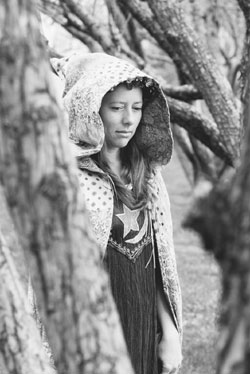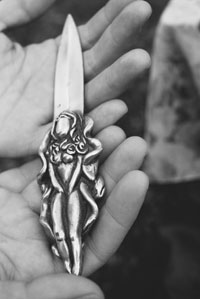|
| ||||||
| The season of the witch
by Jeff Mannix
Placing the first shot across the bow, Easter has its roots as a pagan fertility ritual going back hundreds of centuries before the birth of Jesus and Christianity. This ancient rite of spring was a feast of the Phrygian god Attis, celebrated at the vernal equinox. As all Judeo-Christian celebrations, it was usurped from pagan ritual, renamed and assigned fashionable symbols of the time. In Rome, this feast celebrating the lengthening of daylight and the beginning of the growing season took root precisely at the very places where the death of Christ is worshiped. In the history of civilization, religions evolved on the backs of former religions and all were riding the coattails of the agrarian-based rituals of peasants and nature-based spirituality. That history continues to evolve in the present day, and that nature-based spirituality continues to permeate modern and local culture. “Wicca is an amalgamation of pre-Christian religions that was reinvigorated during the counter culture of the 1960s and is flourishing across America and Western Europe, ” says Melanie Rose, Dianic Wiccan and high priestess of the national organization “Covenant of the Goddess.” Rose lives and practices here in Durango. “We’ve kept a low profile all these years – centuries, really – because proselytizing religions have persecuted this ancient spirituality as having a pact with the Devil, which cannot be further from the truth, since the Devil is a Christian construct, and we are not Christians,” she continues. Wiccans symbolize their beliefs in what’s called a “pentacle,” a five-pointed star within a circle, aggrandizing the spirit and the four basic forces of nature – wind, fire, water, air – enclosed within the wheel of life. “Satanism co-opted the pentacle, turning it upside down to symbolize the goat’s head and a specious association to evilness. We have nothing evil in our religion, just as nature has nothing inherently evil,” explains Rose as she illustrates the pentacle and its misrepresentation. “We are all connected to the ‘source,’ the underlying energy that is spirit, and are only seeking answers in the world around us, which of course is where the answers to life have always been, long before people put human faces on their gods.” The goddess is the foundation of Wicca, as the woman is the foundation of Judaism and other matriarchal societies, according to Rose. “It only makes sense,” she exclaims. “Life is borne by the female, so why would we abandon the female and look to the male for succor? The natural world is often intuited as female: Mother Earth, Mother Nature, The Cosmos.” Modern Wiccan practice can be traced almost entirely through Celtic and Norse tradition, with roots clearly from the early Greek and Asia Minor cultures. Goddesses symbolizing this polytheistic religion are legion, having evolved over centuries from agrarian rituals. Rose’s favorite goddess, the one she turns to for energy and purpose, is Aphrodite, the goddess of the moon and harbinger of love as the moon affects women’s fertility cycles. But each of the eight holidays celebrated by Wiccans throughout the year has its own symbolic goddess, an egalitarian precept that forestalls competition and monopoly.
There are four major agricultural and pastoral festivals and four minor solar festivals of the solstices and equinoxes celebrated in pagan ritual, most beginning at sundown in conformance with the end of the day’s work: Samhain (Oct. 31),Yule (Dec. 21), Imbolc (Feb. 1), Ostara (March 21), Beltaine (May 1), Litha (June 21), Lughnasadh (Aug. 1), and Mabon (Sept. 21). Wiccans call themselves, rather defiantly, witches and practice witchcraft even more defiantly. Witchcraft is explained by Wiccans as a pagan folk-religion of “personal experience rather than transmitted revelation,” and a Witch keeps a “Book of Shadows,” chronicling spiritual enlightenment and progress. Witches can cast spells, called “Spellcraft,” but do it with care and never to inflict harm except to repel harm, according to Rose. A spell is a formula, or series of steps, to direct the will to a desired end. Energy, in a spell, is drawn from the earth, concentrated, and sent out into the world to effect change or to get something desired. “Everything you send out comes back threefold,” says Rose. “It’s like praying, like prayer with props, and involves symbolism, candles and herbs – all drawn from the earth. It’s a conscious direction of will to accomplish a goal.” The mythic witch on a broom comes from rural Europe, where females rode astride a broom through the fields of grain in ceremonies to coax the plant to grow. They would jump over the brooms to show the grain how high they will it to grow. Brooms, of course, are rudimentary tools made from the stalks thrusting the grain to the life force of the sun. Witches practice in covens, mostly outdoors in contact with the earth, where participants – usually numbering no more than 13 – form a circle scribed by a ritual knife called an “athame,” which they believe is charged with the energy of its owner and conducts the owner’s will to the power of nature. Witches do magic, which Rose describes as simply tuning in to the connections between ourselves, the sacred and all of nature. “It is an act of co-creation,” she says, “like prayer acted out in ritual drama. The difference between a Wiccan ritual and going to church – we don’t have a minister preaching a lesson; we have a sacred theatre where members participate.” And responding to the sacrifices that have dogged Witchcraft into disrepute, Rose notes, “All early religions sacrificed animals and even humans to their gods, even ancient pagans. But how many Witches were sacrificed in the name of Christianity? Isn’t that the same thing? But no religion performs ritual sacrifices anymore; Wiccans celebrate life as fundamental to nature.” Wiccans have a code of ethics called “The Wiccan Rede.” Among a litany of permissible behavior, the Rede demands “And harm none, do what thy will,” which Rose explains is similar to the Golden Rule, with “will” meaning one’s true will as opposed to want. It expressly rejects the concept of sin outside of harm to oneself or to another; celebrates sexuality; encourages the natural state of nudity, called “skyclad;” and is generally hedonistic when it comes to living life to its joyous potential. If witchcraft were not freighted with so much fabricated historical nonsense, it would sound remarkably enlightened in today’s conflicted world, where the major religions are still killing devotees heretical to their brand. Who can live in the mountains with its abundant life and dramatic forces, sail the vast sea with its humbling power, see a baby emerge from another fully-sustaining world and not be humbled by nature? That humility is the basis of pagan spirituality. •
|



 With Easter a recent memory, it’s befitting to ask where this holiday and others holding equal or similar reverence truly originated and why.
With Easter a recent memory, it’s befitting to ask where this holiday and others holding equal or similar reverence truly originated and why.
